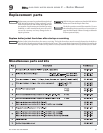
Part number 550-100-026/0404
GAS-FIRED WATER BOILER SERIES 2 — Boiler Manual
30
Annual startup
(continued)
Clean condensate trap
1. Loosen condensate trap line hose clamps and remove
trap line.
2. Empty water from trap line and inspect. Flush out if
needed with fresh water.
3. Check condensate elbow and tee and condensate line
to drain. Flush if necessary to clean.
4. Replace condensate trap line and tighten hose clamps.
5. Fill trap with fresh water by pouring into upturned
end of PVC condensate tee.
Check all piping for leaks
Eliminate all system or boiler leaks.
Continual fresh make-up water will reduce
boiler life. Minerals can build up in sections,
reducing heat transfer, overheating heat
exchanger, and causing heat exchanger
failure. Leaking water may also cause severe
property damage.
1. Inspect all water and gas piping and verify to be leak
free.
2. Look for signs of leaking lines and correct any
problems found.
3. Check gas line using procedure on page 21.
Check air openings
1. Verify that combustion and ventilation air openings
to the boiler room and/or building are open and
unobstructed. Check operation and wiring of
automatic combustion air dampers, if used.
2. Verify that boiler vent discharge and air intake are
clean and free of obstructions.
Flue vent system and air piping
1. Visually inspect entire flue gas venting system (and
air piping, if installed) for blockage, deterioration or
leakage. Repair any joints that show signs of leakage
in accordance with vent manufacturer’s instructions.
When air is ducted to boiler, verify that air inlet hose
is connected and properly sealed.
Failure to inspect for the above conditions
and have them repaired can result in severe
personal injury or death.
Check water system
1. Verify all system components are correctly installed and operational.
2. Check the cold fill pressure for the system. Verify it is correct (usually
around 12 psig).
3. Watch the system pressure as the boiler heats up (during testing) to
ensure pressure doesn’t rise too high. Excessive pressure rise indicates
expansion tank sizing or performance problem.
4. Inspect automatic air vents and air separators. Remove air vent caps and
briefly press push valve to flush vent. Replace caps. Make sure vents do
not leak. Replace any leaking vents.
Check expansion tank
1. Expansion tanks provide space for water to move in and out as the
heating system water expands due to temperature increase or contracts
as the water cools. Tanks may be open, closed or diaphragm or bladder
type. See section 3 of this manual for suggested best location of expansion
tanks and air eliminators.
Open-type — located above highest radiator or baseboard unit, usually
in the attic or closet. Has a gauge glass and overflow pipe to a drain.
Closed-type — welded gas tight and located above boiler. Tank is partially
filled with water, leaving an air cushion for expansion.
• Make sure this type of tank is fitted with a tank fitting, such as the B & G
Tank-Trol or Taco Taco-Trol. This fitting reduces gravity circulation of air-
saturated tank water back to the system and prevents the air from bubbling
up through the water as it returns from the system.
• Do not use automatic air vents in systems with closed-type tanks. The air will
escape from the system instead of returning to the tank. Eventually, the tank
will waterlog and no longer control pressurization. The boiler relief valve will
weep frequently.
Diaphragm- or bladder-type
— welded gas tight with a rubber
membrane to separate the tank pressurizing air and the water. May be
located at any point in the system, but most often found near the boiler.
• Systems with this type of expansion tank require at least one automatic air
vent, preferably located on top of an air eliminator, as shown in examples in
manual section 3.
2. If relief valve has tended to weep frequently, the expansion tank may be
waterlogged or undersized.
Closed-type tank — tank is most likely waterlogged. Install a tank fitting
if not already installed. Then check fill level per fitting manufacturer’s
instructions. If fill level is correct, check tank size against manufacturer’s
instructions. Replace with a larger tank if necessary.
Diaphragm- or bladder-type — first, check tank size to be sure it is large
enough for the system. If size is too small, add additional tank(s) as
necessary to provide sufficient expansion. If tank size is large enough,
remove tank from system and check charge pressure (usually 12 psig for
residential applications). If tank won’t hold pressure, membrane has
been damaged. Replace tank.
8a


















